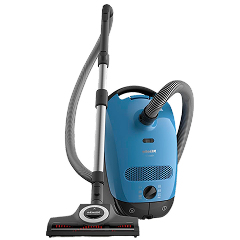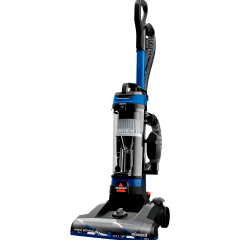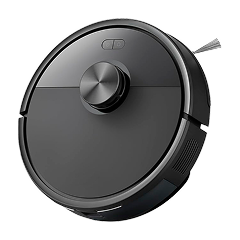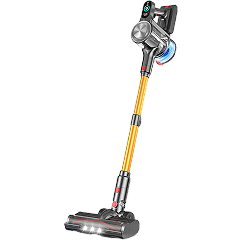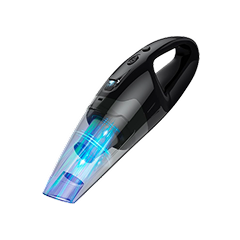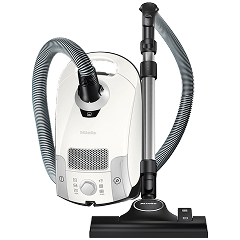Buying vacuum cleaners online can be overwhelming. Not only do you need to decide between different types, features, and price points, but you also need to cut through all the confusing language brands throw up on their pages.
However, there’s no need to worry — I have over a decade of experience testing and writing about vacuums to both the industry ASTM standard and to the approval of homeowners everywhere. In this guide, I’ll go over all the basics and specifics to finding the right vacuum for you and your home.
How to Choose The Right Vacuum Cleaner
Cleaning power
Cleaning power is an important metric for a vacuum, but it can be complicated and vague. There are two categories that measure a vacuum’s motor: suction and wattage.
Wattage is the flow of electricity over time. So a 1,000-watt motor draws more power than a 100-watt motor. It also means that a 1,000-watt motor has more cleaning potential than a weaker motor, but that it’s not a seamless translation. Imagine a car with a powerful motor. A powerful motor creates the potential for a very high top speed. However, if all the tires are flat, you’re not going to get anywhere fast.
The same is true for a vacuum. A powerful motor needs to be paired with:
- A well-sealed chassis to prevent leakage.
- A well-designed brush head for dirt pick up
- A clean filter to assure air flow.
When all these aspects line up, you get a strong partial vacuum, also known as suction.
For uprights, canisters, and some cordless vacuums, that suction is measured in air watts. Air Watts are calculated by multiplying suction power by airflow and dividing that number by 8.5.
Robot vacuum brands tend to list their suction power in Pascals, denoted as pa. When you see a robot vacuum that is advertised as having 1,000 pa of suction, that translates to .1% of the pressure bearing down on you from the atmosphere right now.
So, what is a good wattage or suction power?
Filter types
The most common type of filter is the High-Efficiency Particulate Air or HEPA filter. These are filters that are made from fiberglass, and they strain out small particulates from the air. To be called HEPA, a filter must be able to remove at least 99.97% of particulates greater than .3 microns in diameter. There are several grades higher than that, but this is the minimum.
You may encounter a vacuum that claims to have HEPA-like filters. These are filters that are similar, but don’t meet HEPA standards.
Vacuum brands like Shark also include additional pre-filters. These are foam and mesh filters designed to keep larger particulates like hair from clogging the more expensive HEPA filter, so you can get more use out of it. Pre-filters are often washable.
There are also lines like SEBO, which have electrostatic filters that charge the air with ions to attract very fine dust like a magnet.
Does weight matter?
Weight is a nuanced matter when it comes to vacuums. For the vast majority of people, lighter is better. A heavier vacuum does not mean better quality, higher suction, or a more durable product. And a vacuum that tips the scale harder will be more difficult to push, more fatiguing to carry up stairs, and generally make you want to use it less.
The one exception that comes to mind are Miele vacuums. Some models this brand produces have weights placed inside the chassis of its uprights. These are meant to increase stability so they are less likely to be knocked over or fall over when in use.
Runtime (Cordless)
Excellent battery life depends on the size of the area you’re hoping to clean regularly. For example, if you’re getting a cordless vacuum to spot clean crumbs in your kitchen or to clean a small apartment, a 10-20 minute battery life will suffice. However, if you expect to deep clean your floor and furniture, you’re going to need a more robust battery.
In fact, the most juice you can get from a cordless vacuum is one with a swappable battery. On the premium end of cordless vacuums, units will come with an extra battery that usually has a designated spot inside the charging dock. If you ever need more cleaning time, you can switch to a fresh battery. For more affordable vacuum models, you typically need to purchase extra batteries.
Regardless, a swappable battery not only gives you more immediate cleaning time, but in the long term as well. The battery is often the first point of failure on a cordless vacuum. A swappable battery makes it a simple matter rather than a tedious or expensive repair.
Bagged vs Bagless
The trade-off between bagged and bagless comes down to hygiene versus convenience. The bag itself acts as an additional layer of filtration. Some bagless models compensate by including an additional filter, usually made from mesh or foam.
Bagged vacuums are also more hygienic when it comes to emptying. When you toss the dirt bag away, it won’t cause a dust plume that you get when you open the dirt container of a bagless vacuum. There’s also the added benefit if you’re the type of person who doesn’t like to see, touch, or smell anything unpleasant; the bag helps conceal all that from you.
Bagged vacuums have larger dirty capacities than bagless vacuums. That means emptying less often. However, the consequence of that is that bagged vacuums can get a certain bad odor from the dirt, dust, crumbs, and hair sitting in the bag for months at a time. Dirt cups can also develop that smell, but you can also wash them.
Bagless vacuums also have the advantage of peace of mind of never having to worry about finding compatible bags. Also, some people really like having a view of all the dirt their vacuum suctioned up.
Dustbin capacity
Dustbin or bag capacity refers to how much dirt and debris you can vacuum before you need to change the bag or empty the dustbin.
Noise Level
Vacuum cleaners are noisy. It’s common for a full-sized vacuum to make 72 dBA during operation, which is loud enough to drown out a normal conversation. There are vacuums that have Quiet Modes, which are usually just a reduction in power to the motor. If a vacuum has different cleaning modes, a lighter one will usually reduce the noise it makes.
Brushroll Types
There is also the question of what the brush head is made of. The best brush heads tend to be made of a combination of fluffy and stiff bristles. The fluffy material, usually nylon, is great at removing fine dust that adheres to hardwood. Imagine a mechanized dusting cloth. The stiffer bristles act more like a broom to sweep up larger debris and beat dust out of carpets.
On the more niche front, there are brush heads that are designed to resist hair tangles. This is great for people with pets or a household where one or more members have long hair. And the specialized features don’t stop at the brush head.
Storage
Storage for a vacuum cleaner means two things: onboard storage and general storage. Onboard storage is when attachments and spare parts are stored inside or on the vacuum, and in the case of robot vacuums, also in the charging dock.
The best vacuums can store all their extra parts onboard with a combination of internal compartments and exterior slots. Ideally, a vacuum cleaner shouldn’t make a mess. Onboard storage helps organize, and attachments that are kept at hand will increase your odds of using them to get a superior clean.
When rating general storage, we’re interested in the overall footprint of the vacuum itself and any loose attachments. Uprights have the advantage in this regard as they can stand up on their own. There are select cordless vacuums that can stand up, like those made by Electrolux, but they are moderately rare. Canister vacuums tend to fare the worst when it comes to general storage. The hose often forms a loop that takes up a lot of space.
Attachments
My top three must-have attachments are: the crevice tool, dusting brush, and a mini-brush, preferably motorized.
The crevice tool is sometimes combined with the dusting brush. It’s characterized by having a narrow tip that lets you clean tight spaces. The dusting brush’s bristles allow you to clean around delicate objects.
A mini-brush is a versatile tool that can effectively clean stairs and upholstery. Most mini-brushes are not powered, relying on the air flow of the vacuum’s suction to spin. This is most common on full-sized uprights and canisters.However, it’s very common for cordless vacuums to have powered mini-brushes.
Beyond the must-haves, I have a few choice nice-to-haves.
I like the idea of a spare dusting or a dedicated upholstery brush. If you regularly clean surfaces like pet beds, it’s nice to have a spare brush to avoid cross-contamination.
I’m also a fan of telescopic wands. Not only do they provide extra reach when you need it, but they can also help adjust your canister or cordless vacuum to a comfortable everyday use height.
Ease of cleaning
For manual vacuums, the ease of cleaning usually boils down to the synergy between the motor and the brush roll, swivel joints, and the placement of the handles.
When a vacuum’s motor works well with the brush roll, you get the feeling that the unit is self-propelled. Motors with higher wattages are more likely to have this effect.
Vacuums that advertise swivel or ball joints are also going to be easier to clean with. These joints allow the vacuum to twist and turn on a dime in order to clean around corners and furniture better.
Finally, vacuums with a secondary handle somewhere on the body are more likely to be of higher quality. Having extra and well-placed handles allows you to carry it up the stairs or out of storage.
Smart Features
Smart features are becoming more common, but you’re still most likely going to find them on robot vacuums. Apps for automated floor cleaners can do everything from schedule cleanings to let you stream what the robot sees to your phone.
On full-sized vacuums, compatible apps are more likely to let you order spare parts or look up troubleshooting advice. Some vacuums even had built-in smart features such as sensors that indicate if your floors are clean and even what types of dirt your vacuum is picking up.
Mop Features
Did you know that some vacuums can also mop? Specifically, cordless and robot vacuums can have mop features. For cordless vacuums, you swap out the brush head for a mop head. It uses the power from the motor to cause the mop pads to spin.
On robot vacuums, you can purchase hybrid models that have built-in mop pads and water tanks to help clean sticky messes off the floor. There are even advanced models that had docks that can sanitize the mop pads and refill the onboard water tank.
Types of Vacuums Cleaners
Cordless Vacuums
Cordless vacuums, also known as stick vacuums, are defined by their slim and battery-operated design. In recent years, they’ve come to dominate the vacuum cleaner world. Brands have taken notice and now create models with a variety of feature sets and at every price point.
When a cordless vacuum is super affordable, you can expect it to be a supplemental floor cleaner. They tend to be very light with minimal suction power. Those characteristics make them ideal for spot cleaning frequently dirtied floors, like in the kitchen or entryway.
As you move further up the price ladder, the three metrics that are going to rise the most are: battery life, motor strength, and add-ons. The highest-end models can clean for hours with the help of swappable batteries, have motors that produce enough suction to rival full-sized vacuums, and have features, like self-emptying dirt bins, that make you actually want to use the floor cleaner. They are also probably going to come with more accessories and attachments.
Robot Vacuums
Robot vacuums are automated floor cleaners. They typically come with a charging dock and use a pair of side sweepers and a brush roll to clean. There is also a subsection of robots that are vacuum-mop hybrids, featuring specialized pads and water tanks that can clean up sticky or wet messes.
The docks also vary. Standard docks serve as a home base for the robot to charge and as a starting point for navigation. You may also come across docks that contain secondary vacuums that suction out the contents of the robot’s dirt bin and place the contents into a separate bag.
There are three main advantages of a self-emptying vacuum.
- The first is that it greatly reduces the amount of human interaction the robot requires.
- Second, the bags are often self-sealing, so you never need to see or touch anything unpleasant.
- Finally, the bags help eliminate the odds of reintroducing dust back into your home when you empty the dirt. We should also mention that there are docks that can clean mop pads and provide additional storage for companion cordless vacuums or everyday household items.
The biggest difference between entry-level and high-end models comes down to navigation and smart features. If you’re willing to pay a premium, you can get a robot vacuum with advanced navigation that can recognize and avoid common hazards like power cords, socks, and pet accidents.
On the features front, robot vacuums are getting more connectivity. It’s getting more common for smart mapping that lets you designate areas for the robot to avoid, streaming video, and programming to react to specific conditions like cleaning the entryway when the kids come home from school.
However, no matter how much you spend, a robot vacuum will struggle to compete with a manual cleaning. That’s why I recommend getting one with a scheduling feature so it will automatically clean every day, allowing it to maintain your floors.
Uprights
Upright vacuums are a type of floor cleaner that can be locked into a standing, “upright” position. They are typically designed to focus on floor cleaning rather than attachments. This is evident in their wider and heavier brush heads. The bulkiness also permeates the rest of the vacuum. On average, uprights are the heaviest type of vacuum, tipping the scales at between 15 and 25 pounds or seven to 11 kilograms.
However, this added mass can work out in your favor. Uprights with powerful motors can glide, propelling themselves across even high-pile carpets because of the high mass at the bottom and the leverage of the handle.
Less expensive uprights work great as a “for now” vacuum. Their wider brush heads mean they make short work of a room. They also pair well with a handheld to clean cars, countertops, and upholstery. As you move up the cost ladder, you’re going to find uprights with more powerful motors and more flexible joints that let the brush head glide around furniture more easily.
To overcome the issue with attachments, there are models called “lift-aways” or “crossovers”. These are uprights that can detach from their brush heads with a push of a button to transform them into wheelless canisters. This is especially useful for cleaning stairs, as you can carry the motor position with you.
Canisters
Canisters are the type of vacuum cleaner where the motor is separated from the brush head by a long hose and wand. The motor itself tends to be very low to the ground and follows behind the user, rolling on wheels. Proponents of canisters like them because of how versatile they are. They have the wide brush head of an upright, but with a greater focus on being able to swap attachments.
On the higher end of the price spectrum, the wand is often telescopic. Having an extendable wand helps users clean up high and down low. The svelte nature of the wand allows the brush head to slip under furniture and makes it less fatiguing to hold up when cleaning drapes or tall shelves.
However, no matter how much you pay, canisters will always have a few drawbacks. One is overall storage. Unlike uprights, canisters can’t stand up on their own. There is usually a slot that the brush head can click into, but the inflexible hose will still get in the way no matter what. Also, when you’re moving from room to room, the canister unit can get caught on corners.
Handhelds
Handhelds are the smallest type of vacuum. There are handhelds out there that weight less than 300 grams. They are designed for spot cleaning. For example, there are handheld vacuums specifically made for cleaning keyboards. Because of their small stature, handhelds have a short battery life and limited suction power.
When shopping for handhelds, it’s better to peruse for a purpose first. For example, if you’re looking for a handheld to sit on your kitchen countertop to deal with excess crumbs, then you should start searching for one that can sit in a charging cradle rather than one that needs to be plugged in.
The price point comes next. In my experience, there’s less gradient when it comes to handheld vacuums. If you’re willing to pay top dollar, you might as well go for a cordless vacuum. The most expensive handheld vacuums are cordless models without the extension wand and fewer attachments. This is what the brand Dyson does for its handheld bundles.
What to Look for Based on Your Needs
What are some good vacuum cleaner brands?
Shark
Shark makes some really good general crowd pleasers. They are stuffed to the rafters with features. One that has stood the test of time is the lift-away model. The most popular Shark uprights can detach from their brush heads to become a wheelless canister.
Shark vacuums also tend to come with a full set of attachments and washable prefilters.
On the price front, Shark covers the middle to upper spectrum. You can get a new upright with the lift-away feature for under $200. To get every feature that Shark offers, including a vacuum that adds a pleasant scent to the air, an attachment that can clean the underside of couches and fridges, you’re going to be looking to spend around $500.
The final point in Shark’s favor is that the company covers its models with a robust five-year warranty.
In my experience, Shark is very responsive to consumer wants, so popular models stay in stock while those that don’t sell well disappear very quickly. The company’s manufacturing base is robust, so parts also always seem available.
Dyson
Dyson first made a name for itself in 1993 with its DC01 upright vacuum cleaner. Today, the cordless vacuums take center stage, but the company still manufactures premium uprights, canisters, and robot vacuums.
Products from Dyson show off the company’s commitment to tactile engineering. All the buttons feel good to push, the parts click and snap together in a satisfying manner, and when you clean with them, you’ll feel the power.
For example, some of the latest brush heads have an angled laser that illuminates even the finest dust. So, when you run the vacuum over an area, you just watch all the dust vanish. There’s also an LCD screen on the back that displays the types of dirt the vacuum is picking up, and it will also give you peace of mind when your floors are dust-free.
One thing that stands out to me about Dyson is how easy the upright and canister vacuums are to put together, but they are a hundred times more difficult to take apart if you ever want to return them.
Miele
Meile is a legacy brand with a commitment to quality and innovation. It has the motto “Immer Besser” or Forever Better.
The company’s uprights and canisters are the stars of the lineup. There are a few models of robot vacuums and cordless vacuums, but they are somewhat underwhelming.
What sets Miele’s uprights and canisters apart is the craftsmanship. All the seams, screws, and buttons, received human attention during quality control. When you use a Miele vacuum, everything feels solid and well put together.
If you’ve ever felt frustrated by your upright tipping over when using the hose attachments, Miele solved this problem by adding weights to ensure stability. The canisters often have a ton of built-in cleaning modes like Quiet Mode and a Drapes setting, so you don’t need to play a guessing game when cleaning.
Overall, my experience testing Miele vacuums makes me think they are well worth the investment. However, they are expensive, and the selection is increasingly getting narrower. When I first started testing Miele vacuums ten years ago, there were significantly more models and packages. So if you saw a model in the past you wanted to check out again, it’s likely gone from the retail market.
Bissell
If you’re looking for an affordable upright vacuum, you should check out Bissell. The company makes vacuums that are perfect for people who just want one that’s “good enough”. Bissell’s vacuums tend to be bulky and powerful, with a few nice-to-have features sprinkled in.
For example, there are Bissells with a large one-liter dust bin, excels at cleaning pet hair, and a 27-foot cord that automatically retracts. It’s also very loud and won’t be able to clean under your tables easily.
Also, odds are if you get a Bissell upright, be sure to have a screwdriver when you unpack it. The handle will likely be secured by two screws and there will always be a little bit of jiggle.
iRobot
iRobot is synonymous with robot vacuums. In my experience, whether you’re purchasing their affordable or high-end models, the quality is there.
Even entry-level models have some top-notch features like a dock that auto-empties the robot’s dust bin and smart mapping, so you can tell the robot to focus on or avoid certain areas.
On the higher ends, you’re going to get a robot that can also mop and has visual navigation. Visual navigation is the cutting edge for robot vacuums because it allows the unit to recognize and avoid common obstacles like socks and power cables.
However, in my experience testing iRobots, if you want your robot to clean in and around furniture, get the more affordable models. The better the navigation, the more likely the robot will shy away from tight spaces to prevent getting stuck. Just be aware of that trade-off.
Eufy
Eufy is a spin-off company of electronic manufacturer Anker. It specializes in making affordable home goods. Eufy’s entry-level models have good suction and a low profile that allows it to get under shelves and furniture easily.
Over the years, Eufy has closely followed what its competitors have done. When a feature works well, the next model of Eufy has its own spin on it. For example, when iRobot and Ecovacs started using visual navigation, Eufy eventually came out with its own version, which used similar technology.
Eufy is more or less an Amazon-only brand. This means you get the benefit of Amazon delivery logistics. On the flip side, that also means Amazon pricing, which can cause models to spike and drop in price. For example, data on the popular Eufy 11S Max shows that its price jumps between $104 and $314.
Common Mistakes People Make When Purchasing a Vacuum
Picking price over quality
It’s really easy to choose a product on price alone. We’re all feeling the mounting pressure of inflation. However, if you invest in quality now, it’s going to pay dividends in the long run. Yes, it’s important to shop within your means, but it’s also equally important to shop to meet your needs.
For example, let’s say you have a home with a dog that sheds a lot. If you go for the cheapest vacuum, you may end up wasting hours of time, cutting tangled fur out of the brush roll just to get it to run. Instead, invest a little more and get a vacuum with an anti-tangle brush head that can actually keep your pet’s hair at bay.
Getting a jack of all trades
Expecting one vacuum to clean every surface in your home may lead to frustration. Instead, think about getting specific tools for specific jobs. For example, if you want to keep a countertop crumb-free and your floors spotless, consider getting an upright and a handheld. An extra handheld will prevent cross-contamination and is better suited for cleaning cluttered spaces.
Also, there are messes that vacuums cannot clean. Vacuuming wet messes can damage your floor cleaner.
Not considering your floor type and floor plan
Different types of vacuums have different types of brushes. Wide and stiff bristles are better suited for cleaning carpets. Soft bristles that are more akin to microfiber are better at getting fine dust off bare floors. And some flooring, like wood laid in the parquet style, can be damaged by using the wrong vacuum.
You should also consider cord length. Make sure that the cord length is compatible with your room sizes and outlet placement. You don’t want to be in a situation where you have “dead zones” in your house where your vacuum can’t reach without dragging out an extension cable.
Not thinking about your own physicality
Yes, you want to get a vacuum that suits your home, but what about your body? A big, full-sized vacuum might be very powerful. However, it also might be heavy and difficult to carry up the stairs, especially if it lacks a well-placed handle. A large cleaning width makes short work of rooms, but you might not have considered the amount of furniture you’ll have to move.
On the flipside, if you’re tall, you might want to get a vacuum with a telescopic wand so it can extend and be more comfortable in your hand.
Not keeping the maintenance in mind
A vacuum requires new filters, new bags, and sometimes new belts to keep working. Ensuring that the filters are replaced on time and that you have new bags on hand is important in keeping your floor cleaner in top shape.
So, a mistake people make is that they purchase a vacuum with no regard to getting extra filters, and when their vacuum’s performance starts to drop off or the bag gets full, they have no spare parts to get it up and running again.


